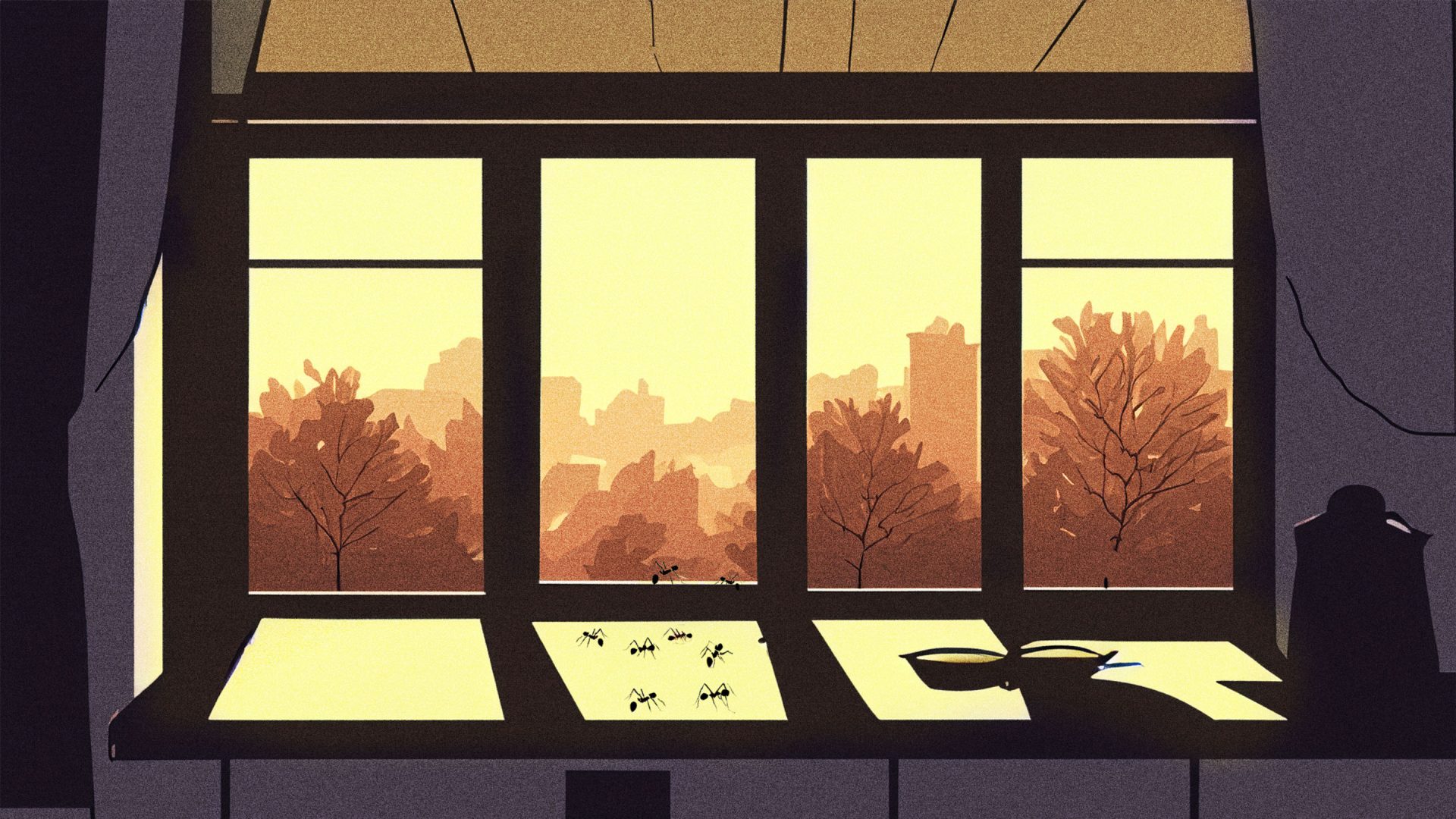It is during wartime that our values are tested. Our war began suddenly on a Tuesday night in April, after the frost in the flower beds had thawed. There were fewer dirty snowpiles in the streets. And the evening sun, as it shone through the unwashed windowpanes, cast mottled patterns on the kitchen floor. Someone shouted in the backyard and hoarse laughter rose above a rooftop, giving voice to the restless excitement that early April brings: confirmation that spring is underway and that you’re already lagging behind. I always find this sense of anticipation makes me feel uneasy: I want to go outside and be a part of spring’s deluge of happenings, but I never quite know how to.
This particular evening was full of that same uneasy anticipation. I was in the kitchen buttering some toast for supper while waiting for something to happen. And as I took the bread out of the drawer, something odd caught my eye. The usual white crumbs in the bread bag had black crumbs among them. Crumbs that moved.
When I took a closer look, I could see how many there were. Tiny little dots, all over the bread, inside the bread bag, and on the kitchen counter. Ants! I watched as one of them raced toward the kitchen cupboard. It was a systematic attack. The invaders had built an entire road network of streaming black dots that stretched all the way along the shelf containing baking ingredients, took a detour via the oatmeal, then forked toward the sugar bag and the flour bag. White sugar grains danced just above the floor, along roads that branched off from one central highway that vanished through a gap under the front door.
We’d had insect invasions before, of course, from fruit flies and flour moths. Every fall, we are visited by a large house spider that lives behind the couch and scares the crap out of us, until we just get used to it being there, at which point it usually just disappears again. But this invasion was bigger, and it felt exciting in the same way that a storm or a power outage, or any event that interrupts normal life, feels exciting. So, I studied the stream of ants while pondering how easily the line between the outside and inside world had been erased.
I’m not sure if I like ants. As a child, they frightened me. Under the loupe, which I borrowed from my grandma’s dusty drawer, they always got too close. They would raise their upper bodies from the ground and fence at me with their antennae. I was used to most animals being timid, and to the idea that having a connection with animals was about building trust. With ants it was the opposite. They would attack whenever the opportunity presented itself.
I stood in the kitchen wondering if that was why I still had an aversion to ants: they are courageous to the very end. There’s nothing I can do to frighten them.
Even when it comes to humankind’s favorite pastime – world domination – we can’t claim any clear victory over ants. For every human on Earth, there are over a million ants. If success is calculated by total biomass – well, some believe that the combined weight of all the world’s ants is greater than the combined weight of every human on Earth. I imagined my body slowly dissolving into a mass of swarming black dots. Was there a swarm of ants equal to my own body weight at the end of this ant trail?
Ants are found in huge numbers, in most habitats, on every continent except for Antarctica. Almost anywhere you are, you can rely on ants being there. That’s the other thing I can remember from my expeditions with Grandma’s loupe. There wasn’t much else to look at. Frogs were difficult to catch. So were flies. But ants were always there, predictably furious.
Back in the kitchen, the ant trail was now streaming out onto the veranda. And so I walked down the back steps and opened the door to the garden to see where the ant trail led. And in the dwindling light of the spring evening, I saw a procession of ants winding its way along the uneven stone wall beside the veranda from the second floor down to the ground.
Beneath the veranda, the ant trail dissolved into the soil. After sundown the heat from the southwest-facing wall keeps the flower bed warm, and in the spring it is the first patch of earth to thaw. A week earlier, I had planted a few spindly bean plants there which I’d tied to a wooden trellis. That’s where all the ants were disappearing. I bent down to find out where they were going and saw that many of them were darting into a hole beneath one of the slabs.
As I stood there, I noticed something strange about my beans. These plants, which had been bursting with sap a few days earlier, were now hanging limply from the twine. The leaves had curled up at the ends, and the angular stalks were covered with tiny black buds that became increasingly dense toward the top. These buds, which looked like teardrop-shaped blisters, were tapered at one end with a powdery black texture similar to a dark plum. They were black aphids and they protruded from the bean stalks with their rear ends aloft. I grimaced and crouched down for a closer look. The top of the plant stem was so infested that when one of the aphids drowsily changed position, all the other aphids’ soft bodies rubbed against each other.
Fascinated and repulsed, I looked down the stem and saw a black ant on its way up, running at full tilt while feeling with its antennae as though it was blind. More ants came running up the stem behind it, although running probably isn’t the right word. Running presupposes an ability to slow down to walking speed, and from what I could see these ants had just the one gear: full speed ahead.
The ants stopped beside a cluster of aphids (again, stopped isn’t the right word because the ants’ forelegs and antennae were constantly moving) and stroked those aphids with their antennae. The whole stalk was a mass of antennae and legs. The ants were more than twice the size of the plump little aphids, and way faster. As the ants swept their antennae over the aphids’ scaly bodies, their automated movements looked like factory workers on an assembly line.
But what happened next was the strangest thing I had seen in a long time. A tiny bubble emerged from an aphid’s rear end. It contained a clear liquid, and it expanded, until after a few seconds the shiny droplet was about a sixth of the size of the aphid itself. One of the nearby ants then stuck its pointy head into the bubble, which became smaller and smaller until finally it was gone. Had this ant been drinking from the aphid?
The sun had set behind the neighboring apartment building, and since I was only wearing a T-shirt I began to get goose bumps on my arms. The flickering light from a TV streamed from a first-floor window, and two young girls stood on a veranda talking excitedly. The scent of dog poop wafted over from the snow piled up near the bike racks. Everything seemed quite normal. But that spring evening had produced some quite unexpected events.
When I returned to my apartment, I started googling “how to kill ants.” But I also began to wonder: How did all these ants find their way into my kitchen so quickly? And what on earth was it that came out of the aphid’s butt?
There’s an old, possibly Chinese, saying that goes: “Know your enemy.” But I knew very little about mine. Ants have simply always been there. They are the annoying things that get in your hair when you’re lying on the grass in the park, that you quickly brush off your clothes, and that live under the slabs in the backyard. At primary school, the kids who liked ants were often the same ones who kept pet spiders and stick insects, which they loved to put in the hair of unsuspecting classmates. The ant lovers in my class were annoying themselves—they were not potential allies in schoolyard battles.
But it was more than springtime curiosity that stopped me from letting the ants have it. I had previously criticized family and friends for using insecticides in their gardens. It would be hard to admit to spreading poison around my own backyard and hear everyone thinking: Oh, our self-righteous idealist has had a reality check.
And so it was with some (self-)satisfaction that I decided to make peace, temporarily, with the ants. It would be a while before anyone with a low tolerance for kitchen irregularities (i.e., my mother) might be visiting. And besides, the ant invasion was exciting; it was something new and in step with the approach of spring. As long as the ants didn’t cross any more boundaries, I would tolerate them being there.
Adapted with permission of the publisher from the book Secret Life of the City: How Nature Thrives in the Urban Wild, written by Hanna Bjørgaas, translated by Matt Bagguley and published by Greystone Books in the United Kingdom in June 2023. Available wherever books are sold










